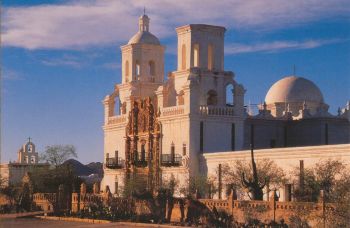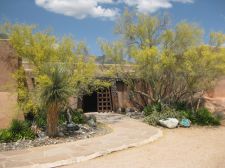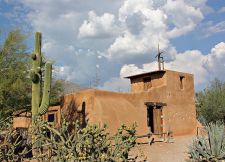Kino Historical Society
Home Page
Eusebio Francisco Kino
1645-1711
The eminent historian of the American West and UCLA librarian Lawrence Clark Powell described Father Kino as "the noblest Southwesterner of all."
Professor Herbert Bolton, director of the Bancroft Library and the father of the study of Spanish colonial history in the United States described Kino as "the most picturesque missionary pioneer of all North America - explorer, astronomer, cartographer, mission builder, ranchman, cattle king and defender of the frontier."
Professor Bolton in his definitive Kino biography "Rim of Christendom" chronicles Kino's life on the frontier as an ardent defender of the O'odham and other Native Peoples and their rights. Bolton described Kino as a latter-day Bartolomé de las Casas (1484-1566) who was one of the first advocates for human rights and the first appointed "Protector de Indios" by the Spanish crown.
Kino was one of the world's greatest missionaries and over 300 years after his death is revered by the Native People he served. Kino wrote that a missionary must have "a strong and loving concern for the temporal and spiritual welfare" of the Native People "while he works hard and maintains a sense of tolerance." Kino was an early advocate of the "preferential option for the poor." For his last 30 years Kino worked on and beyond the Spanish colonial frontier in today's Southwest United States and Northwest Mexico. During his 30 years in the Sonoran Desert and its Pacific coasts and Sky Island Mountain regions, Kino fought for social justice on behalf of the Native People against those European settlers and miners who relentlessly attempted to enslave the Native People and steal their lands. He was a peacemaker on the often violent and lawless Spanish colonial frontier.
For more information about Kino's work as a missionary and Kino's philosophy in his writings,
click Missionary page.
Kino's area of work was in close proximity to mining operations and exploration at a time that the Spanish empire heavily relied on silver taken from Mexico. Many colonists relentlessly attempted to have Kino removed from his missions. This was because Kino required strict observance of the order that Kino petitioned and obtained from the Royal Audencia of Guadalajara that all Indian people including non converts living where he was working were exempt from forced labor drafts for the Spanish mines and ranches, The King's cedula that arrived at the same time as Kino's petiton only exempted converts and not all from forced labor drafts.
In one incident Kino established peace between the Western O'odham and the Spanish military after 5 months of violence. Then Kino rode on horseback 1,500 miles in 7 weeks from his mission headquarters to Mexico City on the Camino Real de la Costa to appear before the highest colonial officials where Kino spoke truth to power. He personally delivered his written report that concluded that the Spanish caused the violence "is evident that the treatment of the Natives in the Pimería has been very unjust— leading as it has to mistreatment, torture and murder." Kino was a friend, advocate and protector of the Native People. For more information
click Ride for Justice and Peace History page and Ride for Justice Journeys page.
The opposition to Kino and the missions continued. The disinformation campaign went as far as trying to provoke war between the O'odham and Spanish based on lies that the O'odham were planning to kill missionaries and Spanish settlers. As part of this campaign a Spanish commander intimidated more than 90 of the O'odham people to leave their homes at Mission Dolores. Kino was away riding the mission circuit. All returned except one. For more information about how the friendshiip and trust between Kino and the O'odham people countered these provocations,
click Friend and Defender page.
Kino also tried to break the cycle of violence as a result of raids of O'odham communities and Spanish settlements by Athabascan speaking groups. Kino continually sent entreaties of peace to these groups.
Kino's work including establishing the Pious Fund of the Californias together with his trail blazing in Baja California, Sinoloa, Sonora, and Arizona led to the Spanish settlement of the state of California 60 years after his death by the Portola & Anza Expeditions. Kino's vision for the Californias and his supply of its restarted missions in Baja is important in understanding Kino's life and work. Kino work oriented the Spainish towards the Californias. Professor Bolton emphasized Kino's work for California as a Pacific Coast Pioneer in the title of his magnum opus about Kino, "Rim of Christendom, Biography of Eusebio Francisco Kino, Pacific Coast Pioneer." For more information about Kino initiating the Spanish settlement of Baja and Alta California,
click California Founder page and California Builder page.
Kino's letters, reports and other writings are the best contemporary records beginning in the later 17th century of the history, ethnology and geography of the Spanish frontier located in today's Arizona and Sonora borderlands. Also Kino's descriptions of his 3 years in Baja California are one of the best accounts of a daily life of a missionary in the New World. For more information about Kino writings,
click Historian page.
While Kino was working in the Spanish frontier, he gained fame in Europe for his maps of the previously unknown Sonoran Desert and the Madrean Mountains Archipelago (Sky Islands). Kino's maps were the definitive maps of the region for over 150 years after his death. For more information about Kino's maps and fame as an explorer,
click Cartographer page and Explorer section page.
Before becoming a New World missionary at age 36, Kino was a mathematics, astronomy and natural sciences professor in Central Europe while completing his training as a Jesuit priest. For more information about Kino's life,
click Europe's Son page, Kino Life section page and Time Line page.
To view and download the best concise Kino biography in "Not Counting the Cost" (27 pg),
click Best Concise Biography page.
For another short Kino biography that is translated in 3 languages,
click English Polzer Biography page, Polzer Spanish Biography page and Polzer Italian Biography page.
To view and download one of the best and most accessible books about Kino's life,
click Best Book page.
To view a great Kino website written in Spanish that summarizes Kino's work along based on Herbert Bolton's and Kino writings with illustrative images and computer generated expedition route maps by Jesus Sortillion,
click El Padre de Sonora page.
In 1965 the citizens of Arizona honored Kino by dedicating before 700 dignitaries from all over the world a statue of Kino at the United States Statuary Hall located in the United States Capitol Building. Kino was one of Arizona's two representatives so honored. The 50th anniversary of the dedication was celebrated in Washington D.C., Arizona and the Italian Province of Trento in 2015. For more information about the Kino statue and speeches,
click US Capitol Statue section page.
After the U.S. statue dedication, the President of Mexico ordered a renewed search for Kino's lost grave. Kino's grave and skeleton was found in May 1966 in Magdalena,Sonora despite a chaotic archeological and historic record and extreme time and budgetary constraints. The international discovery team included historians and anthropologists from the National Institute of Anthroploogy and History (INAH) of Mexico, the Arizona State Museum and the University of Arizona. The discovery is as suspenseful and compelling as any great detective story. For more information,
click Grave Discovery page, Chapel Discovery page and Olvera Discovery Account page.
After the discovery of Kino's grave, the Federal Government of Mexico named Kino a "Hero of Mexico" and the city of Magdalena was renamed Magdalena de Kino. In 1972 a national monument was dedciated with a masoleum over Kino's skeletal remains left in place where they were discovered.
In 2006 the Archdiocese of Hermosillo submitted the 160 pounds of documents for the Vatican's consideration of Kino's cause for sainthood. With the acceptance of Kino's cause he was deemed a Servant of God by the Catholic Church. In July 2020, Kino's sainthood cause passed another important step. the Vatican issued a decree finding that Kino lead a life of heroic virtue and that he now can be called Venerable. This determiination was made after the Vatican scrutinized all Kino's writings, writings of Kino's contemporaries about him and Kino's reputation among historians and the descendants of the people Kino ministered to. There are two steps that Kino's cause must pass before Kino is formally recognized as a saint of the Catholic Church.
For those who believe that Kino is a saint, he is the patron saint for international borderlands of peace and prosperity. Also he is the patron saint for seed savers and sharers. For more information about Kino's sainthood cause,
click Sainthood Cause page.
Since Kino's death in 1711, pilgrims have journeyed in the Fall to Magdalena de Kino and to Kino's grave site to honor the three great Franciscos of the Pimería Alta: Saints Francis Xavier and Francis of Assisi and Father Eusebio Francisco Kino. Kino's Mission San Xavier del Bac outside of Tucson is also an international pilgrimage site. For more information on the Magdalena Pilgrimage and San Xavier del Bac Pilgrimage,
click Kino Pilgrimage page.
For over 35 years the horseback riders of Por Los Caminos de Kino have made annual pilgrimages on horseback (cabalgatas) retracing many of Kino's 50 journeys of exploration. For more information about the Kino rides with route maps,
click Cabalgatas section page.
Kino is well known for his relationships based on respect and friendship with the Native Peoples of the Sonoran Desert. He traveled into their lands to meet them. The Native People would traveled at all times of the year long distances to Kino's twenty-four missions and visiting stations where they would receive his ministry and help him plant and harvest crops and raise cattle, sheep and horses.
Kino worked for almost a quarter century with the Tohono O'odham (Papago), Akimel O'odham (mid Gila River Pima), Hia C'ed O'odham (Sand Papago) and Sobaípuris (River Pima). For information about today's O'odham people,
click O'odham People page.
Kino traveled to the lower Gila and Colorado rivers and to its Pee-Posh (Maricopa), Akwa'ala (Paipai), Cocopah and Quechan (Yuma) people. In his first three years on the frontier Kino peacefully encountered the Cochimi, Monqui, Guaycura, and Pericu of today's Baja California. He also worked among the Comásc (Seri), Yomeme (Yaqui), Yoremem (Mayo) and Edueve (Opata) tribes on the mainland of Mexico.
Kino explored by sail the waters and rode on horseback the lands of more than 30 protected places and areas later set aside by the national governments of the United States and Mexico and the state governments of the Baja Californias, Sinaloa, Sonora and Arizona for natural, cultural and historical conservation purposes For information about national parks, monuments, reserves and wildlife refuges,
click National Parks and Protected Areas page.
For information about selected protected places in Southern Arizona,
click Mission San Xavier del Bac page, San Cayetano de Tumacacori page and Tumacacori page.
Kino's utopian vision was to build new Christian communities among the Native People he worked with. While ministering spiritually to the Native people as a Catholic priest, Kino wanted to better their lives by bringing them European technology and knowledge.
These New World mission communities were based on humanistic ideas of non-violence, equality and communal property as described in the Renaissance book "Utopia" by Thomas More. Their goal was to create true Christian communities like those of the early Christians. The communities would not be transplants or copies from Europe. It was believed that the European societies had fallen into decadence. The New World communities of Native People would be models of true Christian communities and would be key to the restoration of Christianity in Europe and the salvation of the peoples of the entire world.
The New World communities would also provide a place where Native people could survive European colonialism and be able to make the transition in order to co-exist with the colonists. The communities promoted self sufficient economies based on the sharing of communal property and beginnings of self government.
The history of Christian utopian communities are immortalized in Enlightenment and modern literature of Europe. The award winning 1986 movie "The Mission," tells a story of the Guarani people and their Kino era Jesuit missionaries living in one of the mission communities in Paraguay.
Kino's memory is honored widely.
The Kino Border Initiative lead by Kino's Jesuit successors provides humanitarian assistance on the Mexico side of the border by offering emergency aid to migrants who have been deported from the United States. It also advocates for humane treatment of migrants and promotes research and education about the realities of global migration.
Also named for Kino are numerous geographic locations, roads, schools and other public institutions. Artists have memorialized Kino in many forms in paintings, film, music and postage stamps. During the year long celebration of the 300th anniversary of Kino's death, the State of Sonora required the stamp "2011 - Year of Kino" be affixed to all of its official documents.
Monumental statues of Kino grace Tucson, Ambos Nogales, Magdalena de Kino and Kino's Italian homeland in Segno and Trent, Italy. Other statues are in the borderland state capitals of Phoenix, Hermosillo and Tijuana. For more information,
click Statues and Monuments page.
For more information about these and other enduring Kino legacies,
click Kino Heritage section page, Testimonials page, Multimedia Online page, and News.
For resources useful to researchers, teachers and the general reader including Kino's Writings, Guides and Online Resources and summary of Kino's life chapters with maps
click Resources section page, Life Summary Map and Chapters page; and Topical Page Cross References in Kino Books page.
For Kino One Page biography
click Biography 1 pdf.

Mission San Xavier del Bac
San Xavier District of the O'odham Nation
Tucson, Arizona
Mission San Xavier del Bac
At the invitation of the O'odham People, Padre Kino first visited their village of Bac in 1692 and founded Mission San Xavier del Bac. Kino named the mission in honor of his patron saint and exemplar, the great Jesuit missionary to Asia, Francis Xavier. Today the Mission continues to serve the O'odham People as an active parish church.
The Mission San Xavier del Bac attracts visitors annually in the tens of thousands from throughout the world including those journeying on the Camino de Kino pilgrimage trail. The mission is located 10 miles south of downtown Tucson, Arizona on the San Xavier District of the O'odham Nation in the community of Wa:k.
The church's Moorish architecture and Baroque art is considered to be the finest expression of the Spanish Colonial genre in the United States. The Mission is recognized as a National Historic Landmark of the United States and was named to the global World Monuments Fund “Watch” list of irreplaceable heritage sites that are at risk. The Patronato San Xavier, a nonsectarian, nonprofit organization has for over 40 years worked to restore and preserve the Mission church..
For information about the Mission on this website, past and present, including tour information by the docents of the Patronato San Xavier,
click San Xavier Mission page.
"A Gift of Angels: The Art of Mission San Xavier Del Bac" is the definitive book on the statuary, paintings and other art of the Mission.
Associated Kino Organizations
Associazione Culturale Padre Eusebio F. Chini
Kino organization in Europe
Website in English, Italian, Spanish and German
For website, click
http://padrekino.org
Por Los Caminos de Kino & Its Fundación
Kino organization in Mexico
For information in Spanish and English about:
For website, click
http://fundacionkino.blogspot.com/

DeGrazia Gallery in the Sun
Ettore "Ted" DeGrazia Depicts The Life of Padre Kino
Permanent Exhibit of 20 Oil Paintings
DeGrazia Gallery in the Sun
6300 N. Swan Rd.
Tucson, Arizona
Telephone (520) 299-9191 / (800) 886- 5201
Open Daily except select holidays
10 AM to 4 PM.
Entrance Fee for Gallery Admission
For more information, click
https://degrazia.org/
Also visit DeGrazia's Mission in the Sun Chapel, the community chapel non denominational on the Gallery grounds that is dedicated to Father Kino. Free Admission. No Entrance Fee for the chapel and outside grounds.

DeGrazia's Mission in the Sun Chapel
"Dedicated to Father Kino in honor of Our Lady of Guadalupe for the Indians"
Ted DeGrazia - December 12, 1953
No Admission Fee for Chapel
For The General Reader
In a very short time the general reader can have a clear and complete understanding of Father Kino and not get overwhelmed by his event filled life.
The four online sources from this website are recommended for the for the general reader:
1. "Padre Kino and The Trail to the Pacific" and online guides, click
Best Book Page
2. "Kino Life Chapters" with its 3 maps, click
Life Summary Charts and Timeline page.
3. Kino biographical chapter in "Not Counting the Cost", click
Best Concise Biography page.
4. "El Padre de Sonora" website in Spanish with selections from Kino's writings, Bolton's biography of Kino, beautiful illustrative images and computer generated expedition route maps, click on the table of contents page at
http://historiadehermosillo.com/htdocs/kino/KINO/KINO.HTM
For more about the "El Padre de Sonora" website, click
Sortollion Kino Website page
For other Kino biographies set out on this website in Spanish, Italian & English, click
Kino Biography Section page
For links to other definitive works on Kino's life and times, click
Kino Resources Section page
